
Introduction
Tractors are versatile workhorses known for their adaptability across various industries. However, some tasks demand more than a standard tractor can provide. That’s where specialized tractors come into play. These purpose-built machines are tailored to perform specific heavy equipment operations with precision and efficiency. In this article, we’ll delve into the world of specialized tractors and how they enhance productivity in agriculture and construction.
Orchard and Vineyard Tractors:
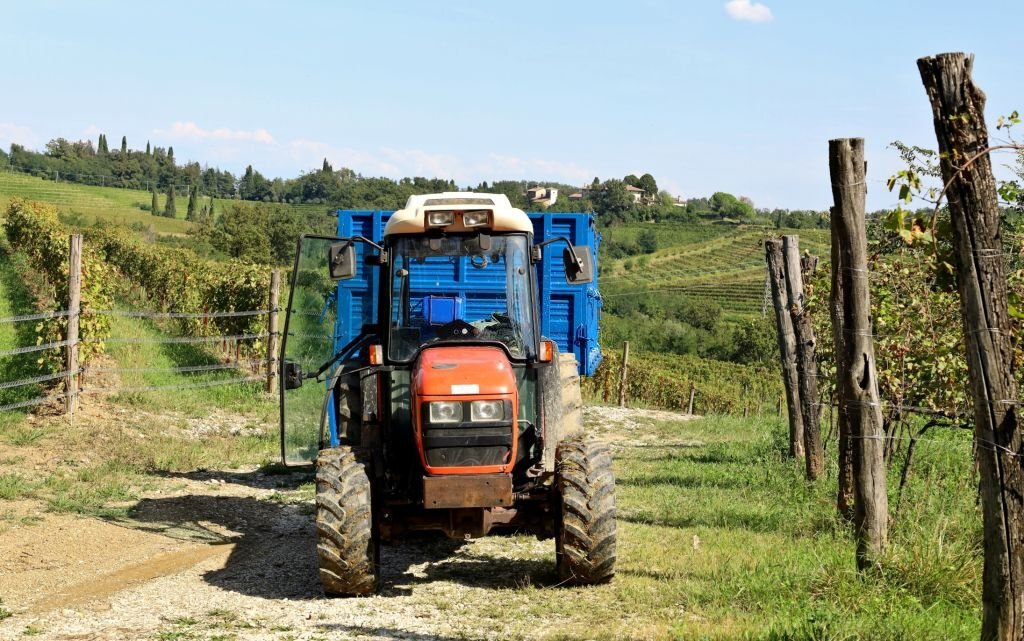
- Narrow Design: Orchard and vineyard tractors are designed with a narrow profile to maneuver easily between rows of trees or vines. They come equipped with specialized attachments for tasks like pruning, harvesting, and canopy management.
- Low Ground Clearance: To prevent damage to low-hanging branches or fruit, these tractors often have low ground clearance.
Orchard and Vineyard Tractors: Nurturing Nature’s Bounty with Precision
Orchards and vineyard tractors are the unsung heroes of specialized agriculture, tending to the delicate needs of fruit-bearing trees and grapevines. These compact and agile machines are designed to navigate the narrow rows and low-hanging branches of orchards and vineyards, making them essential for tasks such as pruning, harvesting, and overall orchard and vineyard maintenance. In this article, we’ll explore the world of orchard and vineyard tractors, their unique features, applications, and their indispensable role in the cultivation of fruits and grapes.
The Beauty of Orchards and Vineyards
Orchards and vineyards are serene landscapes that produce some of nature’s most cherished offerings—fruits and grapes. Cultivating these crops requires meticulous care and precision to ensure healthy yields and top-quality produce. Orchard and vineyard tractors are tailored to meet the specific requirements of these environments.
Key Features of Orchard and Vineyard Tractors
Orchard and vineyard tractors are known for several key features that make them well-suited for these specialized farming tasks:
- Narrow Design: These tractors are intentionally built with a slim profile to fit between rows of trees or grapevines without damaging plants or branches. Their narrowness allows them to navigate confined spaces with ease.
- Low Ground Clearance: Orchard and vineyard tractors often have low ground clearance to avoid damaging low-hanging branches and to provide stability on uneven terrain.
- Specialized Attachments: These tractors can be equipped with various specialized attachments, such as pruners, harvesters, and sprayers, tailored to the unique needs of orchards and vineyards.
- Front-Mounted Implements: Some models feature front-mounted attachments, allowing for precision operations close to the crop, such as pruning or applying fertilizers.
- High Maneuverability: Orchard and vineyard tractors are designed for agility, enabling tight turns and precise control, which is crucial when working around valuable fruit-bearing plants.
2. Row-Crop Tractors:
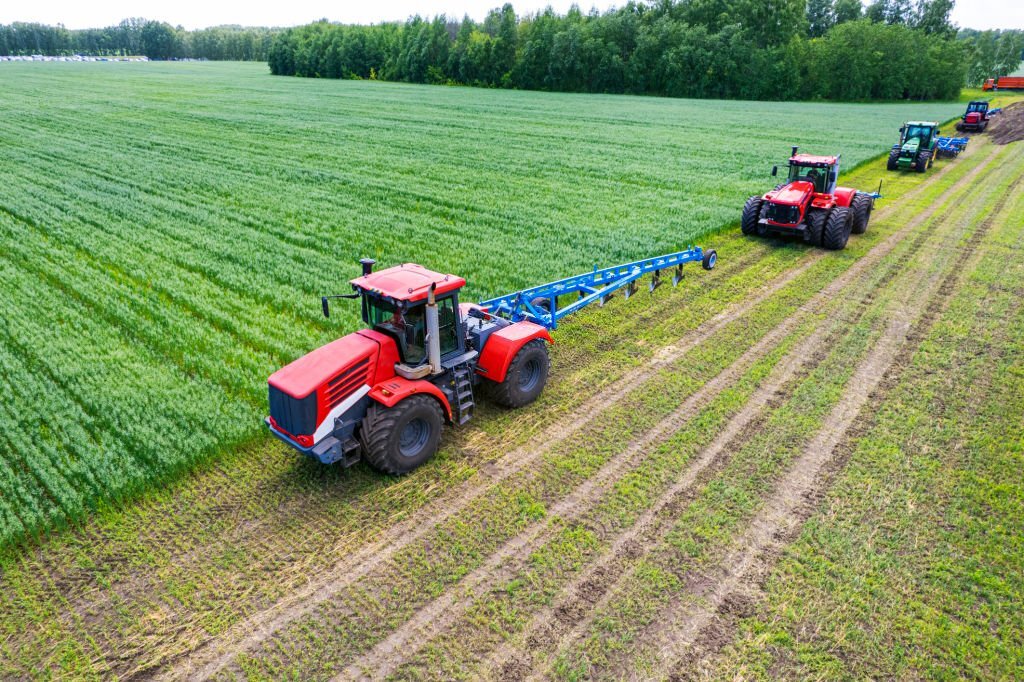
- High Crop Clearance: Row-crop tractors are built with elevated ground clearance to navigate over tall crops like maize or sugarcane.
- Adjustable Wheel Width: The width of the tractor’s wheels can often be adjusted to align with the crop rows for precision planting, cultivating, and harvesting.
Row-Crop Tractors: Precision Farming at Its Finest
Row-crop tractors are the unsung heroes of modern agriculture, combining power, precision, and versatility to maximize crop yields. These specialized machines are designed to navigate the narrow rows of crops, making them essential for planting, cultivating, and harvesting a wide range of row-based crops such as maize, cotton, soybeans, and more. In this article, we’ll delve into the world of row-crop tractors, exploring their unique features, applications, and their vital role in modern farming practices.
Farming in Rows
Row-crop farming is a highly efficient method of crop cultivation where crops are planted in rows, leaving specific gaps between each row. This method allows for better utilization of space, irrigation, and resources while facilitating precision farming techniques.
Key Features of Row-Crop Tractors
Row-crop tractors are characterized by several key features that make them well-suited for row-based farming:
- Narrow Design: These tractors are designed with a narrow profile to fit between rows of crops without damaging plants or soil. Their slim build enables them to navigate tight spaces with ease.
- Adjustable Wheel Width: Row-crop tractors often feature adjustable wheel widths to align with the crop rows, ensuring minimal soil compaction and precise planting, cultivating, and harvesting.
- High Crop Clearance: To clear tall crops, row-crop tractors come with elevated ground clearance, preventing damage to the growing plants.
- Front-Wheel Assist: Many row-crop tractors are equipped with front-wheel assist or mechanical front-wheel drive to enhance traction and stability, especially in wet or uneven fields.
- Hydraulic Systems: These tractors typically feature hydraulics for attaching and operating implements like planters, cultivators, and harvesting equipment.
3. Utility Tractors:
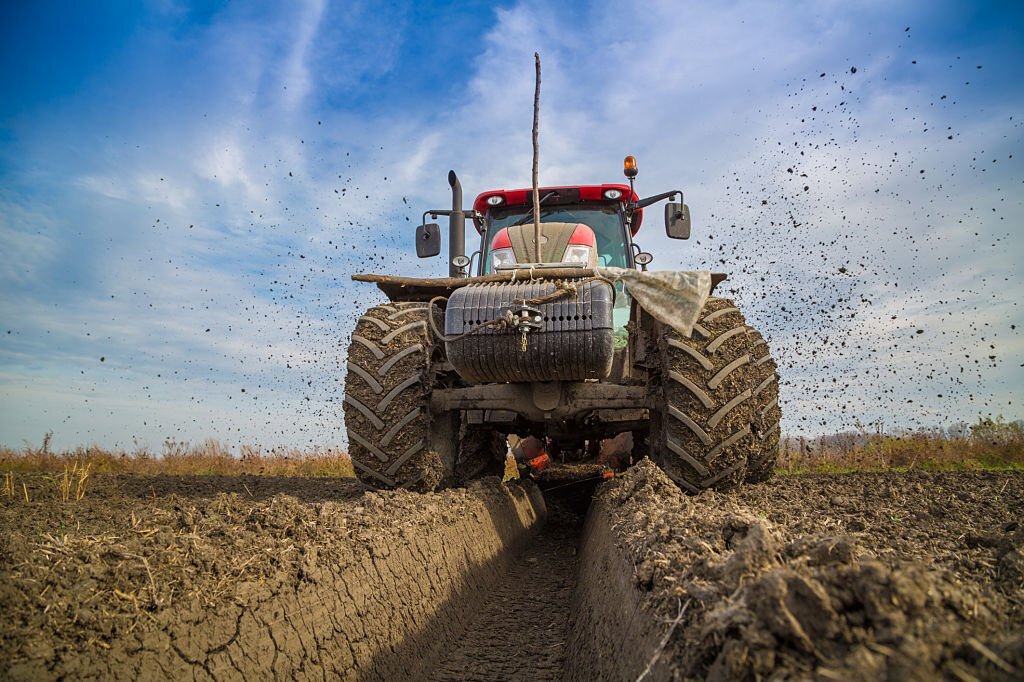
- Versatile Attachments: Utility tractors are designed for general-purpose use and can be fitted with a wide range of attachments, making them adaptable to various tasks on a farm or construction site.
Utility tractors are the Swiss Army knives of the agricultural world. These versatile machines are designed to handle a wide range of tasks on the farm, making them indispensable for farmers and agricultural professionals. In this article, we’ll explore utility tractors, their key features, applications, and how they contribute to the efficiency and productivity of farming operations.
The Heart of Farm Operations
Utility tractors are the workhorses of modern agriculture, and they come in various sizes and configurations to suit different needs. Their versatility and adaptability make them essential for a wide range of tasks on the farm.
Key Features of Utility Tractors
Utility tractors are characterized by several key features that make them suitable for diverse applications:
- Versatile Attachments: These tractors can be equipped with a variety of attachments, including loaders, backhoes, plows, mowers, and more, allowing them to perform tasks like digging, lifting, tilling, and cutting.
- Powerful Engines: Utility tractors are equipped with robust engines capable of delivering the necessary horsepower to handle demanding tasks.
- Three-Point Hitch: Many utility tractors have a three-point hitch system that allows for easy attachment and operation of implements.
- Hydraulic Systems: Hydraulic systems enable operators to control the movements of attachments and implements, making them efficient and easy to use.
- Front Loaders: Some utility tractors come with front loaders, which are invaluable for tasks like material handling, digging, and lifting.
- Four-Wheel Drive (4WD): Many models feature 4WD systems, which provide better traction and stability, especially in challenging terrain.
4. Articulated Tractors:

- Steering Flexibility: Articulated tractors have a unique hinge in the middle, allowing for extreme maneuverability in tight spaces. They are often used in large-scale farming and for heavy-duty construction tasks.
Articulated Tractors: Maneuvering Excellence in Heavy Equipment Operations
Articulated tractors, also known as articulated steering tractors or articulated haulers, represent a remarkable fusion of power and maneuverability. These unique heavy-duty machines are designed to navigate tight spaces and challenging terrains with ease while carrying heavy loads. In this article, we’ll explore the world of articulated tractors, their distinctive features, applications, and how they contribute to various industries.
The Art of Articulation
Articulated tractors are a product of innovative engineering, featuring a distinctive hinge or articulation joint between the front and rear sections. This articulation allows the tractor to pivot in the middle, improving its ability to negotiate tight turns and challenging terrain. Articulated tractors are primarily known for their exceptional maneuverability.
Key Features of Articulated Tractors
Articulated tractors possess several key features that set them apart from other heavy equipment:
- Articulation Joint: The articulation joint, located between the front and rear sections, enables the tractor to steer with precision and flexibility, making it ideal for tight spaces and confined work areas.
- All-Wheel Drive: Most articulated tractors are equipped with all-wheel drive or six-wheel drive systems, providing exceptional traction on uneven or slippery surfaces.
- Heavy-Duty Tires: These tractors often sport large, rugged tires designed to handle rough terrain, mud, rocks, and other challenging conditions.
- High Payload Capacity: Articulated tractors are capable of carrying heavy loads, making them suitable for applications such as material hauling and earthmoving.
- Operator Comfort: Despite their rugged capabilities, many articulated tractors feature comfortable cabs with ergonomic controls, air conditioning, and advanced technology for operator convenience.
5. Crawler Tractors:
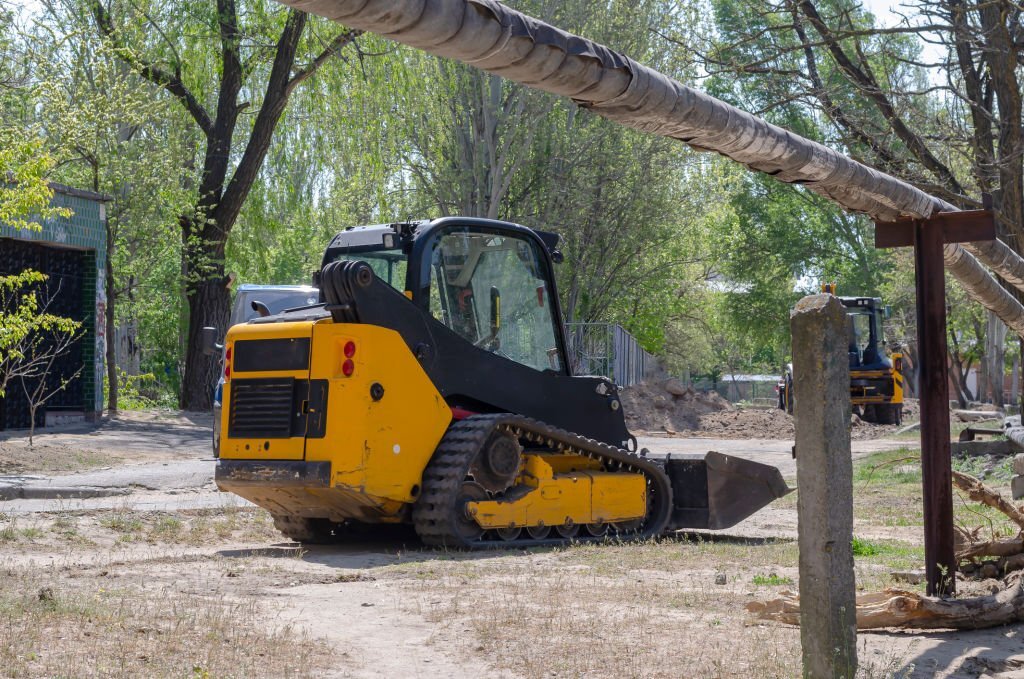
- Tracked Mobility: Crawler tractors, or track-type tractors, are equipped with continuous tracks instead of wheels. They provide exceptional traction and are commonly used in construction, land clearing, and agriculture.
Crawler tractors, often referred to simply as “crawlers” or “track-type tractors,” are heavy-duty machines designed for exceptional power, stability, and traction. These remarkable vehicles are equipped with continuous tracks instead of wheels, making them well-suited for navigating challenging terrains and performing a wide range of heavy equipment operations. In this article, we’ll delve into the world of crawler tractors, exploring their unique features, applications, and contributions to various industries.
The Evolution of Continuous Tracks
The concept of continuous tracks can be traced back to the early 20th century, with pioneers like Benjamin Holt, who developed the first successful track-type tractor. Continuous tracks proved to be revolutionary for heavy equipment, providing advantages such as improved traction, reduced ground pressure, and enhanced stability, particularly in soft or uneven terrain.
Key Features of Crawler Tractors
Crawler tractors are known for their distinctive features that set them apart from wheeled counterparts. Here are some key characteristics:
- Continuous Tracks: The most defining feature of crawler tractors is their continuous tracks, which evenly distribute the machine’s weight over a larger surface area, reducing ground pressure and preventing soil compaction.
- Exceptional Traction: Continuous tracks provide exceptional traction on challenging surfaces like mud, sand, snow, and steep slopes. This makes crawler tractors invaluable in construction, agriculture, forestry, and mining.
- Stability: Crawler tractors are inherently stable due to their low center of gravity and broad footprint. This stability is essential when working on uneven or sloped terrain.
- Heavy-Duty Frames: These tractors are built with robust frames to withstand the stresses of heavy loads and demanding operations.
- Powerful Engines: Crawler tractors are equipped with powerful engines capable of delivering high torque to tackle heavy-duty tasks effectively.
6. Specialty Tractors for Construction:

- Backhoe Loaders stand as stalwarts in the heavy equipment arena, embodying a harmonious fusion of tractor and loader functionalities, often enhanced by a backhoe attachment. This versatility positions them as indispensable assets in the realms of construction and excavation. The tractor component ensures mobility and power, while the loader facilitates the efficient transport of materials. The addition of a backhoe, with its excavation capabilities, transforms these machines into all-in-one workhorses.
- Skid Steer Loaders, on the other hand, epitomizes compact agility, specifically crafted for seamless maneuvering in confined spaces. Their nimble design and ability to rotate within their own footprint make them indispensable in construction and landscaping projects where spatial constraints demand a more agile approach. These versatile machines, equipped with a wide array of attachments, can perform an assortment of tasks, from digging and grading to lifting and transporting materials.
- In essence, both Backhoe Loaders and Skid Steer Loaders represent the pinnacle of efficiency and adaptability in the heavy equipment landscape. Whether it’s the robust combination of a tractor, loader, and backhoe or the compact maneuverability of a skid steer, these machines exemplify the technological prowess that defines the modern approach to construction and landscaping tasks.
7. Forestry Tractors:
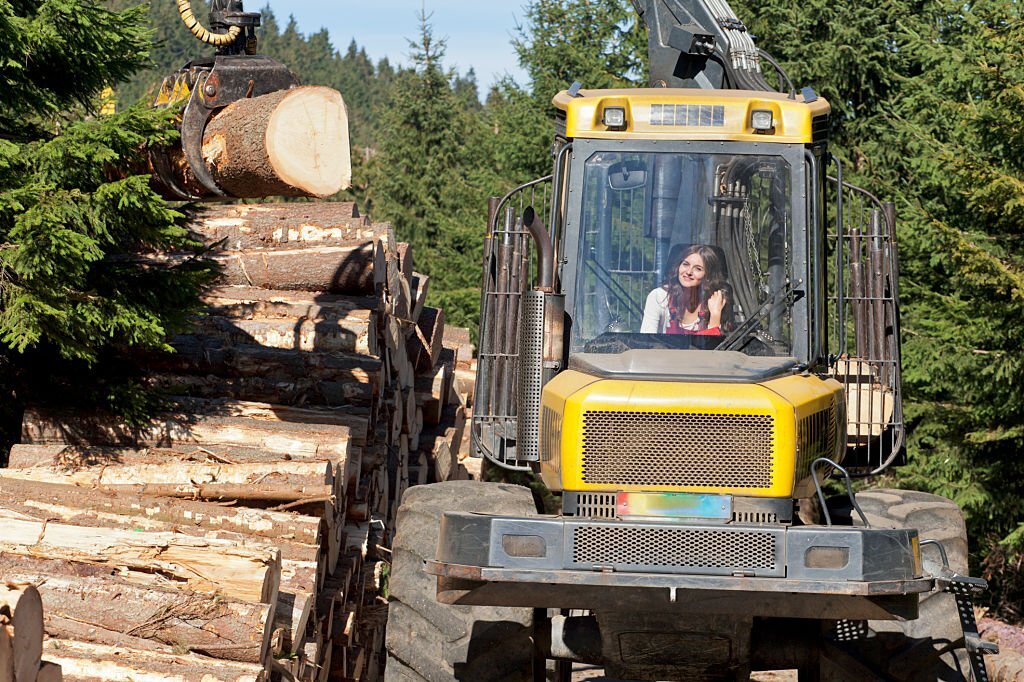
- Forest-Friendly Design: Forestry tractors are adapted for logging and timber operations. They feature protective measures to withstand rugged terrain and forest conditions.
Forestry tractors, also known as forest tractors or forestry skidders, are robust and specialized machines designed to thrive in the rugged and demanding environments of forests. These purpose-built tractors play a crucial role in the forestry industry, where they assist in logging operations, timber extraction, and land management. In this article, we’ll explore the world of forestry tractors, their unique features, and their vital contributions to the sustainable management of forest resources.
The Call of the Forest
Forests are among the Earth’s most valuable ecosystems, providing habitat for wildlife, recreational opportunities, and essential resources like timber. However, accessing and harvesting these resources can be challenging due to the rugged terrain and dense vegetation. This is where forestry tractors come into play, bridging the gap between the wilderness and the modern world.
Key Features of Forestry Tractors
Forestry tractors are purpose-built to withstand the unique challenges of the forest environment. Here are some of their key features:
- Heavy-Duty Frames: Forestry tractors have reinforced frames and chassis designed to endure the stresses of heavy loads and uneven terrain.
- Rugged Tires or Tracks: Many forestry tractors are equipped with wide, aggressive tires or durable tracks that provide stability and traction on challenging surfaces like mud, snow, and steep slopes.
- Protective Measures: These tractors often feature protective measures such as grilles, screens, and reinforced cabs to shield the operator from falling debris and ensure safety in a hazardous environment.
- Winches and Grapples: Forestry tractors are commonly equipped with winches and grapples that enable them to skid logs and move heavy timber efficiently.
- Cab Comfort: Despite the demanding nature of their work, forestry tractors often offer comfortable cabs with ergonomic controls, air conditioning, and heating to keep operators productive and safe.
8. Antique and Vintage Tractors:

- Collectible Machines: Antique and vintage tractors are often sought after by collectors and enthusiasts for their historical significance and unique designs. While not typically used for modern heavy equipment operations, they have a special place in agricultural heritage.
Antique and vintage tractors hold a special place in the hearts of farmers, collectors, and enthusiasts alike. These iconic machines represent a bygone era of agriculture and the remarkable history of farming technology. In this article, we’ll explore the world of antique and vintage tractors, their significance, and why they continue to captivate the imagination of people around the world.
A Glimpse into the Past
The story of antique and vintage tractors begins in the late 19th and early 20th centuries when mechanization revolutionized agriculture. Before tractors, farmers relied on draft animals and manual labor to till the land. The advent of steam-powered and later gasoline-powered tractors marked a significant shift in farming practices. These early tractors, often large and cumbersome, brought unprecedented efficiency to the field.
Key Features and Evolution
Antique and vintage tractors come in various shapes, sizes, and brands, each with its unique features and innovations. Some key aspects of these classic machines include:
- Design Diversity: Antique tractors boast a wide range of designs, from early steam-powered behemoths to compact gasoline-powered models. Vintage tractors introduced streamlined designs and improvements in ergonomics.
- Manufacturers: Numerous manufacturers produced tractors during this era. Companies like John Deere, Ford, International Harvester, Allis-Chalmers, and Massey Ferguson contributed to the tractor legacy.
- Power Sources: Antique tractors were initially powered by steam engines, but as technology advanced, gasoline and diesel engines became prevalent, offering greater efficiency and reliability.
- Two-Cylinder Engines: Some iconic tractors, like the John Deere Model A and Model B, featured distinctive two-cylinder engines, known for their distinctive sound and reliability.
Collectors’ Pride
Today, antique and vintage tractors hold a special place in the hearts of collectors and enthusiasts. Here’s why they are so cherished:
- Historical Significance: Antique tractors provide a tangible link to the agricultural past, reminding us of the hard work and ingenuity that transformed farming.
- Mechanical Artistry: These tractors showcase remarkable engineering and craftsmanship. Collectors admire their mechanical intricacies and attention to detail.
- Restoration Projects: Many collectors take pride in restoring antique tractors to their former glory. This hands-on experience allows them to appreciate the inner workings of these machines.
- Community and Events: Antique tractor shows, parades, and exhibitions provide opportunities for enthusiasts to come together, share stories, and display their beautifully restored tractors.
- Educational Value: Antique tractors offer valuable educational resources, helping new generations learn about the history of agriculture and technology.
Preserving Agricultural Heritage
While antique and vintage tractors may no longer play a primary role in modern farming, they serve as a testament to the roots of agriculture and the enduring spirit of innovation. These iconic machines continue to captivate our imagination, reminding us of the incredible journey from horse-drawn plows to high-powered modern tractors. As collectors and enthusiasts lovingly preserve and showcase these pieces of history, antique and vintage tractors ensure that the agricultural heritage lives on for generations to come.
Conclusion
Specialized tractors are tailored to meet the precise needs of specific heavy equipment operations. Whether it’s navigating through orchards, cultivating row crops, performing construction tasks, or operating in challenging terrains like forests, these purpose-built machines excel in their designated roles. They enhance efficiency, reduce labor, and optimize productivity in agriculture and construction, making them invaluable assets in their respective industries. Specialized tractors demonstrate how innovation and customization continue to drive progress in heavy equipment operations, allowing for greater precision and effectiveness in diverse fields of work.

